Services
Crystal Ridge Dental Centre is a general practice offering family dental services to the residents of Strathmore and surrounding communities, since 1999. Dr. Leanne Lesniak & Dr. Jesse Cockx and their staff strive to create a calm and relaxing atmosphere for all patients.
Dr. Lesniak and Dr. Cockx along with their staff attend continuing education courses and seminars to provide you with up to date treatments and care. We use both digital x-rays and photos which allows you to see what we see. These images help you understand the treatment recommendations so you can make the best informed decisions for your oral health.
Children’s Dental Care: We provide check-ups and cleanings to children in our community. Many new parents are left feeling uncertain about oral health for children. Below is some information on brushing and flossing, understanding primary teeth and many other services we offer.
Preventative Maintenance:
This includes but is not limited to: examinations, x-rays, scaling, polish, fluoride, sealants.
The dental exam is critical to your ongoing oral health which your dentist can perform. The exam consists of the dentist looking inside your mouth, and referencing current and previous dental x-rays.
Basic, Cosmetic & Major Restorative Treatments:
This includes but is not limited to: fillings, root canals, extractions, whitening, crowns, bridges, veneers & implant restorations.
Crystal Ridge Dental Center proudly adheres to the Infection Prevention and Control Policies outlined by the Alberta Dental Association & College and Alberta Health Services.
If you have any questions or concerns about our sterilization techniques and standards please feel free to ask any of our staff.
If you have further questions or concerns about the services offered in our office, the lovely ladies at our front desk would be able to assist you over the phone or in person. We also offer sedation dentistry.
Services
Choose a service from the list to learn more information.
Dental Crowns
Dental crowns are used to restore teeth that are heavily damaged or decayed, or to replace an old filling. In addition to enhancing your smile, crowns help to improve your teeth’s strength and protect them from further damage. Types of dental crowns can include the full porcelain crown, the porcelain-fused-to-metal crown and the all-metal crown.
Placing a crown requires a minimum of 2 dental visits. The process involves:
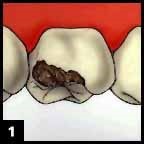
Step 1.
Decay is first removed and the tooth is shaped and prepared.
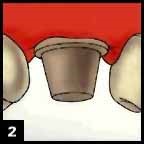
Step 2.
An impression is made and a temporary crown is placed.
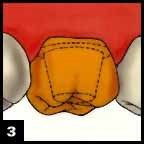
Step 3.
During your second visit, the temporary crown is removed and a permanent crown is placed.
Porcelain Veneers
Porcelain veneers offer one of the many ways in which you can restore your teeth. These thin shells are affixed to the surface of the teeth and can serve a number of purposes like:
- Giving a new shiny exterior to discoloured or stained teeth.
- Reshaping misaligned teeth.
- Rebuilding chipped teeth.
- Closing odd gaps between teeth.
- Repairing naturally worn down teeth.
The biggest advantage porcelain veneers offer is a natural look, as the texture of this material matches that of natural teeth. Before going through any procedure, our dentists will carefully analyze your situation in order to make sure which procedure is best for you.
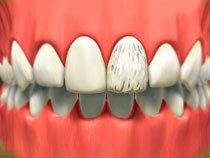
Step 1.
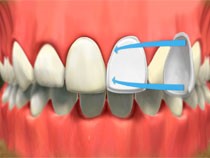
Step 2.

Step 3.
Root Canal Therapy
Your teeth’s roots are important for keeping your teeth healthy and strong. This is because the roots supply your teeth with nourishment. However, if the roots become damaged, it can lead to problems for the tooth, and even cause it to die. This can cause a number of painful symptoms including:
- Excruciating pain when drinking hot or cold liquids
- Difficulty with chewing due to pain
- Abscessing of the tooth
- Swollen gums
- Pain in the ears, jaw or head
- Waking or loss of sleep
To save the tooth, root canal therapy may need to be performed. This procedure involves removing the decayed dental pulp from the tooth and cleaning the inner chamber to eliminate the source of the problem. Once it is thoroughly cleaned, the inner chamber is refilled with a biocompatible filling material before the tooth is resealed. We recommend placing a dental crown on top of the tooth to strengthen and protect its structure. Before performing any root canal therapy, we will perform a complete examination of your mouth to determine if the dental pulp is infected. This includes using digital x-rays to get a complete in-depth look of your teeth and bone tissues. If root canal treatment is needed, we will perform it with an anesthesia to ensure your complete comfort.
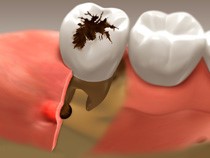
Step 1.
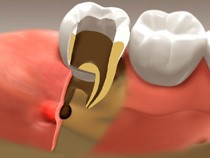
Step 2.

Step 3.

Step 4.
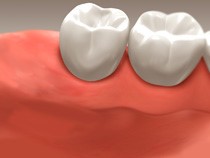
Step 5.
Sedation Dentistry
Oral Conscious Sedation – Anxiety and Pain Free Dentistry
Also known as sedation dentistry, oral conscious sedation is used to ease patient’s nervousness, especially for those who suffer from dental phobia. Oral conscious sedation is also ideal for patients who require complicated / multiple dental procedures.
We offer two types of sedation. Monitored conscious sedation and Nitrous oxide, commonly known as laughing gas. These options are offered to all ages. For monitored conscious sedation, patients will need someone to drive them to and from their appointment and should not operate any equipment or machinery over the next 24 hours.
Dental Bridges
Replace Missing Teeth

No one enjoys having complications arise as a result of having missing teeth. Not only does it ruin your smile, it can compromise your oral health. Missing teeth can put additional pressure on remaining teeth and increase the chances of further decay and gum disease.
One way to replace missing teeth is with a dental bridge. A bridge is one or more artificial teeth that are anchored in place by the remaining teeth that surround the gap, left by the missing tooth/teeth.
To place a bridge, your anchoring teeth may have to be filed down to accommodate for a dental crown. An impression of your teeth will also be taken to create your customized bridge. You will be placed with a temporary bridge in the meantime.
- Fits a temporary or transitional bridge.
Once your permanent bridge is ready, you will return to the office to have the temporary bridge removed. Your permanent bridge is attached and adjusted to complete your new smile.
Dental Implant Restorations
After surgical placement, and healing time of an implant at the oral surgeon’s office, our office can place a final restoration. These restorations include crowns and bridges. Much like a traditional crown and bridge, this process requires at least 2 appointments; one to take impressions to send to the lab for the restoration to be made, and one to insert the final restoration.
Not everyone is a candidate for implants – the gum tissue and bone must be in optimum health for the process to be successful. Ask our office for an assessment to determine the best course of action to replace missing teeth for you.
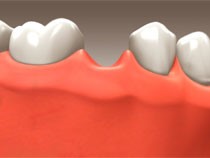
Step 1.
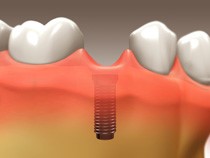
Step 2.
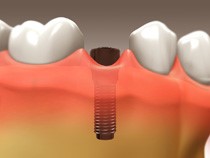
Step 3.
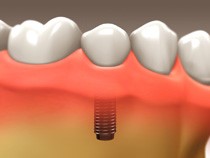
Step 4.

Step 5.
Whitening
Our office offers 2 types of take home whitening kits. Please call our office to discuss if you are a good candidate for our whitening kits.
Dental Fillings
Dental Amalgam Fillings
Dental amalgam fillings are sometimes called “silver” fillings. They are the most common type of filling used in Canada today. Because these fillings are silver in colour, they are used to fill back teeth. They are a mix of metals such as mercury, silver, copper and tin.
Advantages
- These fillings are the least expensive type of filling.
- They last a long time.
- They are easy to put in place; because they are a direct filling, one visit to your dentist will do the job, in most cases.
Disadvantages
- The silver colour may not appeal to people who want a “natural” look.
- Tiny amounts of mercury are released from the filling when you chew. For most people, this bit of mercury is nothing to worry about. Studies have shown that amalgam fillings do not cause illness. They have been used on people for more than 150 years.
- Health Canada advises pregnant women in need of a filling to wait until the baby is born before they go ahead with the procedure. Your dentist can suggest other kinds of fillings, if the work is urgent.
Composite fillings are also called plastic or white fillings. Getting this kind of filling depends on where the tooth is in your mouth. We bite down hard on our back teeth (molars), so a plastic filling may not be a good choice. Talk to your dentist about other options.
To place this filling, your dentist cleans all decay from the tooth and puts a glue (or bonding material) on the inside of the hole. Composite resin is put into the hole in thin layers. Each layer gets hard with the help of a special light that your dentist holds over the tooth. When the last layer of the filling is hard, your dentist shapes the filling so it looks and feels natural.
Advantages
- These fillings will be the same colour as your natural teeth.
- They are direct fillings, so they can be done in one appointment, in most cases.
Disadvantages
- This kind of filling can break more easily than amalgam, and may not last as long.
- Composite fillings cost more than amalgam fillings.
- Recurrent decay is more of a problem than with amalgam.
- Increased sensitivity than amalgam fillings.
Glass ionomer materials are only used in teeth where you do not bite down hard. There have not been many studies about how long this kind of filling lasts. Newer forms of the filling may be stronger and last longer. Research is underway to evaluate the effectiveness of these materials.
Advantages
- These fillings are the same colour as your natural teeth.
- They contain fluoride, which helps stop recurrent decay in the tooth.
- They do not have to be put in layer by layer; thus, they are simpler to put in than composite resins.
- They are direct fillings and can be done in one appointment, in most cases.
Disadvantages
- They are not as strong and will not last as long as other fillings.
- They cost more than amalgam fillings.
Here is the latest information about composite resin vs amalgam restorations published in Issue 5/2018/CDA essentials.
Dental Sealants
Dental tooth decay is more prevalent on the biting surfaces of the posterior teeth. While the proper oral hygiene is essential to prevent decay at times the anatomy of the tooth is such that it is impossible to clean properly. Dental caries is caused by plaque, a sticky film of bacteria that occurs on all teeth. When food is eaten these bacteria eat the food and produce acid which destroys the tooth. While good oral hygiene does not let food remain in the mouth, at times it is impossible to clean the pits, fissures, and grooves of the teeth. These areas can be protected by the application of dental sealants.
A sealant is a clear or tooth coloured coating of those areas that cannot be cleaned by a toothbrush. Sealants can be clear or appropriately tinted to assist identification after being applied to the pits and grooves. They are applied to the biting surface of the molars and premolars, which are most decay prone. These coatings prevent food and bacteria from lodging in the deep groves of the posterior teeth, preventing decay.
Dental sealants should be applied to all teeth of children with deep grooves. Although children can benefit most, adults can also be candidates for this procedure.
Each tooth only takes a short time to seal.
- The teeth to be sealed are cleaned.
- The surface of the teeth are etched with a weak solution to assist the sealant’s adherence.
- The sealant material is brushed onto the teeth.
- The material is set in place with a light.
Sealants last for several years. Dentists monitor the status of the sealants, and will inform patients if they should be reapplied. Sealants’ life span depends upon eating habits. Chewing ice, hard candies, and popcorn kernels can wear and dislodge the bond.
The Primary Teeth
The primary teeth (a much better phrase than “baby teeth”) are far more important to your child’s future dental health than you may imagine. In addition to providing a proper chewing surface until age 12 or 13, normal healthy primary teeth form pillars that allow young mouths to develop correctly.
Without the primary teeth, the permanent teeth which replace them could not assume their proper position in the mouth. The primary teeth help guide the permanent teeth into their final position. The primary molars are especially important. If a primary molar is lost prematurely and steps are not taken to preserve proper spacing, problems can quickly multiply.
Regular visits to the dentist are essential part of maintaining dental health.
Brushing and Flossing
Brushing
Proper brushing can help reduce the risk of tooth decay and gum disease. Brushing for at least 3 minutes twice a day will help remove plaque from the surfaces of your teeth. Brush twice daily with a soft toothbrush that is not worn out or frayed. Your toothbrush needs to be replaced every 3 to 4 months.
Adults and children over age 3 years should use a toothpaste with fluoride. The use of topical fluoride, which is in toothpastes, gels, and rinses, has been shown to reduce dental cavities. It is important that young children are closely monitored when using fluoride-containing products so that they do not ingest an excessive amount. Only a pea-sized amount of toothpaste is necessary for a child to use.
Steps for getting the most out of your brushing:
- Place the toothbrush against your gum line (where the teeth and gums meet) at a 45-degree angle. Use a small circular motion to brush your teeth and gums.
- Brush the inner surfaces or backs of your front teeth with the front part of your toothbrush.
- Brush back and forth on the chewing surfaces of your teeth holding the brush flat.
- Brush for at least 3 minutes two times a day. Be sure to brush at bedtime to remove bacteria that can cause decay while you are sleeping.
Flossing
Flossing cleans between teeth where a toothbrush can’t reach. Flossing also helps control bad breath. By combining flossing and brushing each day, you can thoroughly remove plaque and prevent cavities and gum disease.
Steps for getting the most out of flossing:
- Wrap about 18 inches of floss around you middle fingers.
- Gently slide the floss between the teeth (don’t snap the floss into the gums).
- As the floss reaches the gum line, make a C-shape around the tooth until you feel pressure against your tooth.
- Gently scrape the tooth surface with the floss.
- Move the floss as it becomes soiled and repeat process for each tooth.
Silver Diamine Flouride
Information for patients
To stop tooth decay quickly, without pain and injection in certain cases where once drilling and restorations were necessary.
What is Silver Diamine Fluoride?
Silver Diamine Fluoride (SDF) is a liquid used on cavities to arrest tooth decay. In some cases where dentists were used to do regular dental restorations, it is now possible to use an atraumatic, non-invasive treatment to stop the caries process. It can also help relieve sensitivity.
How does SDF work?
The silver ions acts as an antimicrobial agent against the caries, while the fluoride ion acts to prevent further demineralization.
For which situations is SDF ideal?
- Around margins of restorations to prevent secondary decay
- To avoid general anesthesia or oral sedation
- If you are anxious with dental treatments
- For cavities that cannot be treated in 1 visit
- If you have:
- Difficult access to dental care
- Difficult to treat dental caries
- A high risk of developing caries
- Adults, elderly patients and kids of any age!
Does SDF replace all regular dental restorations?
No. SDF can be used to stop the cavity and give you time before you choose to have it removed and filled. In certain cases, the cavity does not need to be removed and SDF is used to simply stop it’s process.
Are there any post treatment instructions?
There are no postoperative limitations. You may eat or drink immediately and proceed with your regular dental care routine at home.
Are there any risks?
SDF will stain demineralized areas and soft-tissues brown or black. It does not stain healthy teeth.
Is there a way to minimize stain?
Your dentist will be able to reduce the dark appearance by applying a dental restorations called composites, glass ionomer, composites, amalgams or crowns.
How long do the effects last?
If your dentist applied any type of restoration, the SDF will be better protected. In that case, it is possible that no further treatment is necessary. If no restoration was applied, or if the caries was more severe, it is recommended to re-apply SDF every 6 to 12 months.
Is SDF indicated for kids?
SDF is indicated by Health Canada to be used on children 3 years and older.
Scientific literature shows that SDF is also completely safe for kids under 3 years old.

Wisdom Teeth
Wisdom teeth, or third molars, are the last permanent teeth to appear (erupt) in the mouth. These teeth usually appear between the ages of 17 and 25. Some people never develop wisdom teeth. For others, wisdom teeth erupt normally — just as their other molars did — and cause no problems, and for many people, the wisdom teeth can cause crowding, pain or infection and need to be removed.
Tooth Extraction
Tooth extraction is the removal of a tooth from its socket in the bone. If you are facing a tooth extraction, it can seem a little daunting and nerve-wracking. But did you know that tooth extraction is a relatively standard dental procedure
When Is Tooth Extraction Necessary?
In many cases, you can repair teeth that are broken or damaged by decay with a filling, crown, or other dental treatment. Sometimes, though, the damage is too severe to repair, so your dentist will recommend extraction.
Here are some other reasons tooth extraction might be necessary:
- Decay or infection has reached deep into the tooth
- Trauma or injury
- There isn’t enough room for all the teeth in your mouth
- Baby teeth don’t fall out in time for the permanent teeth to come in
- Orthodontic treatment might require tooth extraction to create room for the teeth as they move into place
- Wisdom teeth, also called third molars, are often extracted either before or after they come in
Preparation
Before removing a tooth, your dentist will thoroughly review your medical and dental history and take the appropriate X-rays. X-rays reveal the length, shape, and position of the tooth and surrounding bone. From this information, your dentist can determine the best way to remove the tooth or whether to refer you to an oral surgeon.
Before removal during a simple extraction, we will numb the area around your tooth using local anesthetic. However, during a more complicated removal, called a surgical extraction, we may suggest monitored conscious sedation or even refer you to an oral surgeon.
TMJ/Night Grinding Appliances
After a thorough examination and, if needed, appropriate x-rays, we may suggest a plan to treat your TMJ. This treatment plan may include relaxation techniques, a referral to a physiotherapist, a chiropractor or a behavioural therapist to help you ease muscle pain. Other treatment options may include medicine for pain, inflammation or tense muscles. If getting a good night’s sleep is a problem, a number of approaches to improve sleep may be used.
We may suggest wearing a night guard, also called an occlusal splint. It is made of clear plastic and fits over the biting surfaces of the teeth of one jaw so that you bite against the splint rather than your teeth. This often helps your jaw joints and muscles to relax. There are different appliance options to choose from based on your needs and we have a fantastic technician that fabricates these appliances for you. For many people, a night grinding appliance can save them hundreds if not thousands of dollars from wear and tear on their teeth. Most insurance companies will cover the cost of these appliances.
Services
Choose a service from the list to learn more information.
